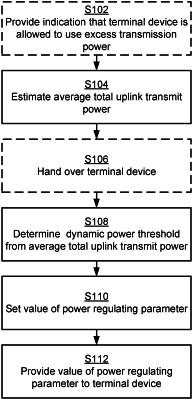| CPC H04W 52/146 (2013.01) [H04W 52/367 (2013.01)] | 16 Claims |

|
1. A method for uplink average power control of a terminal device, the method being performed in a network serving the terminal device, wherein the network comprises a first radio access network node and a second radio access network node, the method comprising:
estimating average total uplink transmit power for the terminal device;
determining a dynamic power threshold from the average total uplink transmit power according to a back-off average power control loop, wherein, in the back-off average power control loop, a setpoint value of total average transmission power is compared with a value of the estimated average total uplink transmit power;
setting a value of a power regulating parameter as a function of the dynamic power threshold;
providing the value of the power regulating parameter to the terminal device for uplink power control of the terminal device; and
handing over the terminal device from the first radio access network node to the second radio access network node after having estimated the average total uplink transmit power for the terminal device, wherein the average total uplink transmit power for the terminal device is estimated by a controller of the first radio access network node, and wherein the value of the power regulating parameter is provided to the terminal device from the second radio access network node upon the terminal device having been handed over from the first radio access network node to the second radio access network node.
|